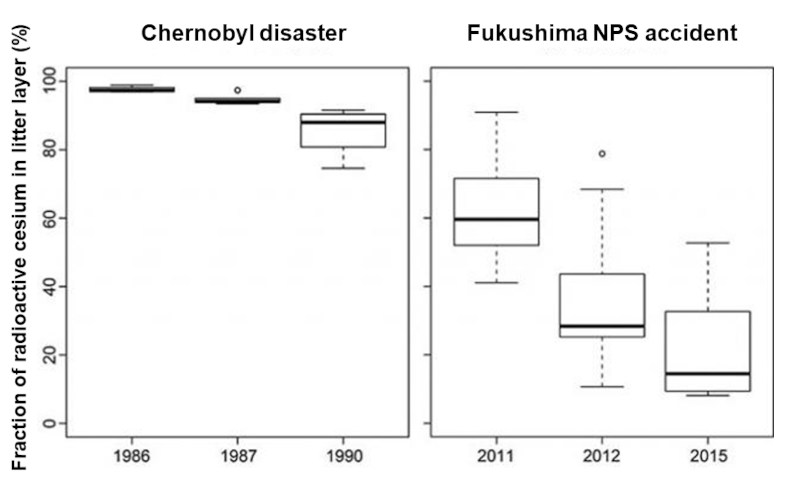Radioactivity Dynamics in forests
(2021)
QIs the downward migration of radioactive cesium in forest soils in Japan after the Fukushima accident any different from the movement of radioactive cesium around Chernobyl after the Chernobyl disaster?
AUsing survey data on radioactive cesium in forest soils at 99 locations in Eastern Japan, the Forestry and Forest Products Research Institute investigated the fraction in the litter layer and analyzed the migration center depth of radioactive cesium distributed in the mineral soil layers. As a result, it was found that the rates of migration of radioactive cesium from the litter layer to the mineral soil layers and its downward migration within mineral soil layers in Eastern Japan are higher than that in soils around Chernobyl after the Chernobyl disaster.

Fig. 1 Movement of radioactive cesium from litter layer to mineral soil layers
Fraction of radioactive cesium in the litter layer within the soil (litter layer + mineral soil layers) on the year of, one year after, and four years after the Chernobyl disaster and Fukushima Daiichi NPS accident. A lower fraction means more radioactive cesium existing in mineral soil layers. In the figure, the values were sorted from the smallest number to the largest number, and the bottom line indicates the minimum value, the bottom of the box a quarter of the data group, the bold line the median, the top of the box three quarters of the data group, and the top line the maximum value. A circle indicates an outlier.
It is known that radioactive cesium that deposited on the forest soil migrates from the litter layer to the mineral soil layers, and then further slowly migrates downward within the mineral soil layers. Determining the rates of such migrations of radioactive cesium within the forest soil leads to evaluation of exposure doses and amount absorbed by trees, and provides vital information for planning future forest use.
Using survey data on radioactive cesium in forest soils at 99 locations in Eastern Japan, the Forestry and Forest Products Research Institute investigated the fraction in the litter layer and analyzed the migration center depth of radioactive cesium distributed in the mineral soil layers. As a result, it was found that about 70% of radioactive cesium that was present in the litter layer had moved to the mineral soil layers beneath it by 2012, one year after the accident (Fig. 1), and then further migrated to lower layers within the mineral soil layers. This study revealed that the rates of migration of radioactive cesium from the litter layer to the mineral soil layers and its downward migration within mineral soil layers in Eastern Japan are higher than that in soils around Chernobyl after the Chernobyl disaster (Fig. 1). This was most likely due to the differences in the characteristics of the litter layer, climate, and the physicochemical form of the initial deposition.
It’s been 10 years since the accident at the Fukushima Daiichi NPS. Chronological analysis of data obtained and comparison with the survey results after the Chernobyl disaster make it possible to more accurately predict the movement of radioactive cesium in the forest ecosystem in Japan.
(Research results from the Forestry and Forest Products Research Institute and others. Reproduced from the website of the Forestry and Forest Products Research Institute (partly edited by JAEA))
Related articles
- I heard most of the forests would not be decontaminated. Does cesium remain in the forests?
- How does radioactive cesium in forests move from trees to the ground surface? 【Movement in throughfall, stemflow, and litterfall】
- How does radioactive cesium in forests move from trees to the ground surface? 【Movement as particulate and dissolved states】
